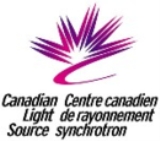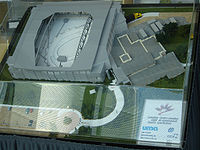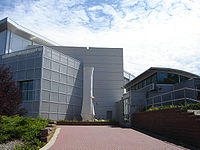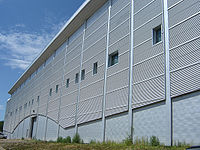
Canadian Light Source Synchrotron
Encyclopedia




GEV
GEV or GeV may stand for:*GeV or gigaelectronvolt, a unit of energy equal to billion electron volts*GEV or Grid Enabled Vehicle that is fully or partially powered by the electric grid, see plug-in electric vehicle...
synchrotron
Synchrotron
A synchrotron is a particular type of cyclic particle accelerator in which the magnetic field and the electric field are carefully synchronised with the travelling particle beam. The proton synchrotron was originally conceived by Sir Marcus Oliphant...
located in Saskatoon, Saskatchewan, Canada
Canada
Canada is a North American country consisting of ten provinces and three territories. Located in the northern part of the continent, it extends from the Atlantic Ocean in the east to the Pacific Ocean in the west, and northward into the Arctic Ocean...
. It opened on October 22, 2004 after three years of construction and cost C$173.5 million. One of forty-two such facilities in the world, it occupies a footprint the size of a football field on the grounds of the University of Saskatchewan
University of Saskatchewan
The University of Saskatchewan is a Canadian public research university, founded in 1907, and located on the east side of the South Saskatchewan River in Saskatoon, Saskatchewan, Canada. An "Act to establish and incorporate a University for the Province of Saskatchewan" was passed by the...
. The CLS, which is the only synchrotron in Canada, is operated by CLS Inc. a not-for-profit corporation owned by the University of Saskatchewan.
Overview
A synchrotronSynchrotron
A synchrotron is a particular type of cyclic particle accelerator in which the magnetic field and the electric field are carefully synchronised with the travelling particle beam. The proton synchrotron was originally conceived by Sir Marcus Oliphant...
is the most common high-energy particle accelerator
Particle accelerator
A particle accelerator is a device that uses electromagnetic fields to propel charged particles to high speeds and to contain them in well-defined beams. An ordinary CRT television set is a simple form of accelerator. There are two basic types: electrostatic and oscillating field accelerators.In...
, consisting of a toroidal vacuum tube surrounded by electromagnet
Electromagnet
An electromagnet is a type of magnet in which the magnetic field is produced by the flow of electric current. The magnetic field disappears when the current is turned off...
s. Charged particles are directed by the electromagnets to remain near the center of the vacuum tube, traveling in orbits around the ring. At points along the ring waveguides inject radio energy into the cavity, creating regions of high electrical potential. The charged particles are accelerated in these regions, gaining energy with every pass around the ring. Since the particles vary in speed while they are accelerated, typical synchrotron installations consist of two or more such rings, a "booster ring" for acceleration over a range of speeds, and the "storage ring" for maintaining the particles at a fixed energy. Synchrotrons can be "tuned" to confine specific particles, common examples being electron
Electron
The electron is a subatomic particle with a negative elementary electric charge. It has no known components or substructure; in other words, it is generally thought to be an elementary particle. An electron has a mass that is approximately 1/1836 that of the proton...
s or proton
Proton
The proton is a subatomic particle with the symbol or and a positive electric charge of 1 elementary charge. One or more protons are present in the nucleus of each atom, along with neutrons. The number of protons in each atom is its atomic number....
s.
In the case of electrons, the acceleration around the ring causes them to lose energy through a process known as synchrotron radiation
Synchrotron radiation
The electromagnetic radiation emitted when charged particles are accelerated radially is called synchrotron radiation. It is produced in synchrotrons using bending magnets, undulators and/or wigglers...
. The energy is lost in the form of photon
Photon
In physics, a photon is an elementary particle, the quantum of the electromagnetic interaction and the basic unit of light and all other forms of electromagnetic radiation. It is also the force carrier for the electromagnetic force...
s, light, across the electromagnetic spectrum
Electromagnetic spectrum
The electromagnetic spectrum is the range of all possible frequencies of electromagnetic radiation. The "electromagnetic spectrum" of an object is the characteristic distribution of electromagnetic radiation emitted or absorbed by that particular object....
including infrared
Infrared
Infrared light is electromagnetic radiation with a wavelength longer than that of visible light, measured from the nominal edge of visible red light at 0.74 micrometres , and extending conventionally to 300 µm...
, ultraviolet
Ultraviolet
Ultraviolet light is electromagnetic radiation with a wavelength shorter than that of visible light, but longer than X-rays, in the range 10 nm to 400 nm, and energies from 3 eV to 124 eV...
and X-rays. The light is separated into "interesting frequencies" to produce very bright almost monochromatic light, and shone down beamline
Beamline
In particle physics, a beamline is the line in a linear accelerator along which a beam of particles travels. It may also refer to the line of travel within a bending section such as a storage ring or cyclotron, or an external beam extracted from a cyclic accelerator.In materials science, physics,...
s to endstations (small laboratories) where scientists can “see” the microscopic nature of matter, right down to the level of the atom.
Synchrotrons like the CLS can be used to probe the structure
Structure
Structure is a fundamental, tangible or intangible notion referring to the recognition, observation, nature, and permanence of patterns and relationships of entities. This notion may itself be an object, such as a built structure, or an attribute, such as the structure of society...
of matter
Matter
Matter is a general term for the substance of which all physical objects consist. Typically, matter includes atoms and other particles which have mass. A common way of defining matter is as anything that has mass and occupies volume...
and analyze a host of physical, chemical, geological and biological processes. Information obtained by scientists can be used to help design new drugs, examine the structure of surfaces in order to develop more effective motor oils, medical imaging
Medical imaging
Medical imaging is the technique and process used to create images of the human body for clinical purposes or medical science...
of tumours and other biological tissue
Biological tissue
Tissue is a cellular organizational level intermediate between cells and a complete organism. A tissue is an ensemble of cells, not necessarily identical, but from the same origin, that together carry out a specific function. These are called tissues because of their identical functioning...
s, build more powerful computer chips, develop new materials for safer medical implants
Implant (body modification)
In body modification, an implant is a device placed under the human skin for decorative purposes. Such implants may be subdermal or transdermal...
, and help with clean-up of mining wastes
Tailings
Tailings, also called mine dumps, slimes, tails, leach residue, or slickens, are the materials left over after the process of separating the valuable fraction from the uneconomic fraction of an ore...
, to name just a few applications.
Before The CLS
The first accelerator research programs at the University of Saskatchewan was established in 1948, when Canada's first betatronBetatron
A betatron is a cyclotron developed by Donald Kerst at the University of Illinois in 1940 to accelerate electrons, but the concepts ultimately originate from Rolf Widerøe and previous development occurred in Germany through Max Steenbeck in the 1930s. The betatron is essentially a transformer with...
(a 25 MeV machine) was constructed in the Physics Building. Based on this early success in 1951 the world's first non-commercial cobalt-60
Cobalt-60
Cobalt-60, , is a synthetic radioactive isotope of cobalt. Due to its half-life of 5.27 years, is not found in nature. It is produced artificially by neutron activation of . decays by beta decay to the stable isotope nickel-60...
therapy unit for the treatment of cancer was constructed on campus and then in 1961 construction of the Saskatchewan Accelerator Laboratory
Saskatchewan Accelerator Laboratory
The Saskatchewan Accelerator Laboratory was a linear accelerator facility on the University of Saskatchewan campus in Saskatoon, Saskatchewan, Canada. The facility was constructed in 1961 at a cost of $1.7M under the direction of Leon Katz. SAL was identified by the OECD as a National...
(SAL) started and was completed in 1964. In 1999 SAL operations were discontinued and the accelerator used as an injector for the CLS. In addition to the CLS the University continues to operate a small Tokamak
Tokamak
A tokamak is a device using a magnetic field to confine a plasma in the shape of a torus . Achieving a stable plasma equilibrium requires magnetic field lines that move around the torus in a helical shape...
as part of the Plasma Physics Laboratory
Plasma Physics Laboratory (Saskatchewan)
The Plasma Physics Laboratory at the University of Saskatchewan was established in 1959 by H. M. Skarsgard. Early work centered on research with a Betatron.-STOR-1M:STOR-1M is Canada's first tokamak built in 1983...
.
Prior to the CLS, Canada (through the University of Western Ontario
University of Western Ontario
The University of Western Ontario is a public research university located in London, Ontario, Canada. The university's main campus covers of land, with the Thames River cutting through the eastern portion of the main campus. Western administers its programs through 12 different faculties and...
) operated several beamlines at the similar Synchrotron Radiation Center
Synchrotron Radiation Center
The Synchrotron Radiation Center , located at the University of Wisconsin–Madison, is a national synchrotron-radiation light source research facility....
(SRC), at the University of Wisconsin–Madison
University of Wisconsin–Madison
The University of Wisconsin–Madison is a public research university located in Madison, Wisconsin, United States. Founded in 1848, UW–Madison is the flagship campus of the University of Wisconsin System. It became a land-grant institution in 1866...
, in Stoughton, Wisconsin
Stoughton, Wisconsin
Stoughton is a city in Dane County, Wisconsin, United States and is a neighbor of Madison. It straddles the Yahara River about 20 miles southeast of the capital, Madison. Stoughton is part of the Madison Metropolitan Statistical Area...
.
The CLS Project
On March 31 1999 The Canada Foundation for InnovationCanada Foundation for Innovation
Created by the Government of Canada in 1997, the Canada Foundation for Innovation strives to build our nation’s capacity to undertake world-class research and technology development to benefit Canadians...
provided partial funding for the construction of the CLS facility. The remaining matching funds from Saskatchewan, Ontario, Alberta, Saskatoon and industry would follow between 1999 and 2001. The CLS is one of the largest science project in Canadian history, and represents an unprecedented level of cooperation between the Government of Canada
Government of Canada
The Government of Canada, formally Her Majesty's Government, is the system whereby the federation of Canada is administered by a common authority; in Canadian English, the term can mean either the collective set of institutions or specifically the Queen-in-Council...
, the governments of Saskatchewan
Saskatchewan
Saskatchewan is a prairie province in Canada, which has an area of . Saskatchewan is bordered on the west by Alberta, on the north by the Northwest Territories, on the east by Manitoba, and on the south by the U.S. states of Montana and North Dakota....
, Ontario
Ontario
Ontario is a province of Canada, located in east-central Canada. It is Canada's most populous province and second largest in total area. It is home to the nation's most populous city, Toronto, and the nation's capital, Ottawa....
and Alberta
Alberta
Alberta is a province of Canada. It had an estimated population of 3.7 million in 2010 making it the most populous of Canada's three prairie provinces...
, the City of Saskatoon
Saskatoon
Saskatoon is a city in central Saskatchewan, Canada, on the South Saskatchewan River. Residents of the city of Saskatoon are called Saskatonians. The city is surrounded by the Rural Municipality of Corman Park No. 344....
, universities across Canada
Canada
Canada is a North American country consisting of ten provinces and three territories. Located in the northern part of the continent, it extends from the Atlantic Ocean in the east to the Pacific Ocean in the west, and northward into the Arctic Ocean...
and industry.
On 21 September 1999 The CLS project was officially launched. On 21 February 2001 the CLS building expansion was completed. The SAL linac was refurbished and placed back into service on 13 September while the Booster Ring (BR1) and Storage Ring (SR1) were still under construction. First turn was achieved in the BR1 ring in July 2002 with BR1 fully commissioned by September 2002. First turn in the SR1 ring was achieved on September 2003, with first light in December. In April 2004 SR1 achieved 100 mA.
In 2002 the CLS Project was awarded the National Award for Exceptional Engineering Achievement by the Canadian Council of Professional Engineers
Canadian Council of Professional Engineers
The Canadian Council of Professional Engineers , operating with the business name of Engineers Canada, is the national organization of the 12 provincial and territorial associations that regulate the practice of engineering in Canada...
.
The CLS Project was officially completed June 30, 2005.
Operation
On 15 July 2004 CLS received regulatory approval from the CNSCCanadian Nuclear Safety Commission
The Canadian Nuclear Safety Commission , previously known as the Atomic Energy Control Board , is the governmental nuclear power and materials watchdog in Canada...
for normal operation. The grand opening occurred in October 2004. On May 19 2005 Her Majesty Queen Elizabeth II
Elizabeth II of the United Kingdom
Elizabeth II is the constitutional monarch of 16 sovereign states known as the Commonwealth realms: the United Kingdom, Canada, Australia, New Zealand, Jamaica, Barbados, the Bahamas, Grenada, Papua New Guinea, the Solomon Islands, Tuvalu, Saint Lucia, Saint Vincent and the Grenadines, Belize,...
(Queen of Canada) and His Royal Highness The Duke of Edinburgh
Prince Philip, Duke of Edinburgh
Prince Philip, Duke of Edinburgh is the husband of Elizabeth II. He is the United Kingdom's longest-serving consort and the oldest serving spouse of a reigning British monarch....
visited the CLS. A few days later on May 27 the first experiment by an outside user was conducted.
Phase II Beamlines
On March 8 2004 CLS received partial funding ($18M) from the Canadian Foundation for Innovation for the phase II beamline expansion project.http://www.lightsource.ca/media/CFI.php The phase II beamlines include:- Biomedical Imaging and Therapy (BMIT), $17M;
- Soft X-Ray Beamline for Microcharacterization of Materials, $4M;
- Very Sensitive Elemental and Structural Probe Employing Radiation from a Synchrotron (VESPERS), $4.5M;
- Resonant Elastic and Inelastic Soft X-Ray Scattering (RIXS), $8.3M; and
- High-Throughput Macromolecular Crystallography, $10.4M.
- A sixth project, the Synchrotron Laboratory for Micro and Nano Devices (SyLMAND) was funded independently of CFI.
Phase III Beamlines
On November 27 2006, the Canadian Foundation for Innovation awarded a further $25.8 million for the initial funding of a phase III expansion project, consisting of five new beamlines. Phase III will include:- The Brockhouse X-ray Diffraction and Scattering Sector (BXDS), 2 beamlines;
- BioXAS: Life Science Beamline for X-ray Absorption Spectroscopy (BioXAS), 3 beamlines;
- The Quantum Materials Spectroscopy Centre (QMSC), 1 beamline.
Linac
Originally part of the SAL facility, the linear accelerator was refurbished and modified in 1999-2000 to become the injector for the CLS. Originally intended to operate at 180 Hz, the linac was modified for 1 Hz operation. The linac is followed by an Energy Compression System and then a 70 m transfer line (LTB1) that delivers the beam to the booster ring (BR1).Booster Ring (BR1)
Beam is delivered to the booster at 200-250 MeV where it is accelerated to a final energy of 2.9 GeV. The Booster ring was manufactured by Danfysik with final installation and assembly done at the CLSI. The booster ring uses an RF frequency of 500 MHz. The beam is extracted from the booster and transferred through the BTS line and into the SR1 ring.Storage Ring (SR1)
The SR1 ring was designed and assembled by CLSI. The storage ring uses a 12-fold periodic layout of cells consisting of dipole, quadrupole and sextupole magnets to create a stable operating region for the beam. For high quality light sources, insertion devices (wigglers or undulators) are placed in the straight sections between the magnets. To accommodate a large number of users at the same time, nine straight sections are available for insertion devices. The synchrotron light from any of the dipole magnets in the lattice is also available to users.Initially, the stored current will be only 200 mA due to the RF power constraints. Based on the anticipated lifetime of the stored beam, the storage ring will be re-filled at intervals of 4 to 12 hours.
Isotope Linac
In 2011 the Canadian Light Source received $12 Million Canadian in funding to purchase and operate a four meter long linear accelerator for the production and study of isotopes used in nuclear medicine.SR1 Beamlines
| ID | Name | Port | Phase | Energy (keV) | Usage |
|---|---|---|---|---|---|
| BMIT-BM | Biomedical Imaging and Therapy | 05B1-1 | 2 | 8–40 | Biomedical Imaging and Therapy |
| BMIT-ID | Biomedical Imaging and Therapy | 05ID-1/05ID-2 | 2 | 20–100 | Provides advanced imaging for medicine and high-precision radiation therapies for cancer. |
| CMCF | Canadian Macromolecular Crystallography Facility | 08ID-1 | 1 | 6.5–18 | Protein crystallography beamline suitable for studying small crystals and crystals with large unit cells. |
| CMCF2 | Canadian Macromolecular Crystallography Facility | 08B1-1 | 2 | 4–18 | Atomic-scale imaging of molecules such as viral and bacterial proteins used for drug design. |
| Far IR | High Resolution Far Infrared Spectroscopy | 02B1-1 | 1 | 10-1000 cm-1 | Spectroscopic study of molecules |
| HXMA | Hard X-ray micro-Analysis | 06ID-1 | 1 | 5–40 | X-ray Absorption Fine Structure (XAFS), microprobe, diffraction and imaging |
| Mid IR | Mid IR Spectromicroscopy | 01B1-1 | 1 | 560-6000 cm-1 | Endstation: Bruker Vertex 70v/S Spectrometer, a Hyperion 3000 IR microscope with a 64x64 element focal plane array detector and various single element detectors Photoacoustic spectroscopy Photoacoustic spectroscopy Photoacoustic spectroscopy is the measurement of the effect of absorbed electromagnetic energy on matter by means of acoustic detection. The discovery of the photoacoustic effect dates to 1880 when Alexander Graham Bell showed that thin discs emitted sound when exposed to a beam of sunlight that... (PAS), Time resolved spectroscopy, Phase modulation |
| OSR | Optical Syncrotron Radiation | 02B1-2 | 1 | Accelerator diagnostic beamline. Internal CLS use. | |
| REIXS | Resonant Elastic and Inelastic X-ray Scattering | 10ID-2 | 2 | 0.08–2.0 | Atomic-scale microscopy with applications in environmental science and advanced materials. |
| SGM | High Resolution Spherical Grating Monochromator | 11ID-1 | 1 | 0.24–2.0 | X-ray Absorption Spectroscopy (XAS), X-ray Photoelectron Spectroscopy (XPS), Auger Electron Spectroscopy (AES), X-ray Excited Optical Luminescence (XEOL), Photoemission Electron Microscope (PEEM) and Gas phase photoionization and TOF measurements |
| SM | Soft X-ray Spectromicroscopy | 10ID-1 | 1 | 0.1–2 | Polymer science and biological applications, novel material design and magnetic imaging |
| SXRMB | Soft X-ray Microcharacterization Beamline | 06B1-1 | 2 | 1.7–10 | Determine materials structures to nanometre scales with applications in environment, electronics, and medicine. |
| SyLMAND | Synchrotron Laboratory for Micro And Nano Devices | 03B1-1/03B1-2 | 2 | 1–15 | Research in and fabrication of polymer microstructures |
| VESPERS | Very Sensitive Elemental and Structural Probe Employing Radiation from a Synchrotron | 07B2-1 | 2 | 6–30 | Determine trace elements and crystal structure in microsamples with applications to mineral ores and metals. |
| VLS-PGM | Variable Line Spacing Plane Grating Monochromator | 11ID-2 | 1 | 0.055–0.25 | X-ray Absorption Spectroscopy (XAS), X-ray Excited Optical Luminescence (XEOL) and Photoemission Electron Microscopy (PEEM) |
| XSR | X-Ray Syncrotron Radiation | 02B2 | 1 | Accelerator diagnostic beamline. Internal CLS use. |
Executive Directors, past and present
- Dennis Skopik - Acting Director (May 1999 - Sept. 1999)
- Michael Bancroft - Interim Director (Sept. 1999 - Oct. 2001)
- Mark de Jong - Acting Director (Oct. 2001 - Nov. 2002)
- Bill Thomlinson - Executive Director (Nov. 2002- August 2008)
- Josef Hormes - Executive Director (August 2008 - )
See also
- List of synchrotron radiation facilities
- Plasma Physics Laboratory (Saskatchewan)Plasma Physics Laboratory (Saskatchewan)The Plasma Physics Laboratory at the University of Saskatchewan was established in 1959 by H. M. Skarsgard. Early work centered on research with a Betatron.-STOR-1M:STOR-1M is Canada's first tokamak built in 1983...
- Saskatchewan Accelerator LaboratorySaskatchewan Accelerator LaboratoryThe Saskatchewan Accelerator Laboratory was a linear accelerator facility on the University of Saskatchewan campus in Saskatoon, Saskatchewan, Canada. The facility was constructed in 1961 at a cost of $1.7M under the direction of Leon Katz. SAL was identified by the OECD as a National...
- Innovation Place Research ParkInnovation Place Research ParkInnovation Place is the registered business name of the Saskatchewan Opportunities Corporation , a crown corporation in Saskatchewan. SOCO operates a network of three research parks: one located near the University of Saskatchewan in Saskatoon, Saskatchewan, the second near the University of Regina...
- Vaccine and Infectious Disease OrganizationVaccine and Infectious Disease OrganizationThe Vaccine and Infectious Disease Organization is a non-profit organization owned by the University of Saskatchewan and operates with financial support from the governments of Saskatchewan and Alberta as well as Government of Canada and industry competitive grants...
- EPICSEPICSThe Experimental Physics and Industrial Control System is a software environment used to develop and implement distributed control systems to operate devices such as particle accelerators, telescopes and other large experiments. EPICS also provides SCADA capabilities...
(Used for Accelerator and Beamline Control Systems) - Canadian government scientific research organizationsCanadian government scientific research organizationsExpenditures by federal and provincial organizations on scientific research and development accounted for about 10% of all such spending in Canada in 2006...
- Canadian university scientific research organizationsCanadian university scientific research organizationsExpenditures by Canadian universities on scientific research and development accounted for about 40% of all spending on scientific research and development in Canada in 2006....
- Canadian industrial research and development organizationsCanadian industrial research and development organizationsExpenditures by Canadian corporations on research and development accounted for about 50% of all spending on scientific research and development in Canada in 2007....
External links
- Canadian Light Source Website
- CLS Synchrotron FAQ (CBC)
- Lightsources.org
- Queen of Canada's Day in Saskatoon
- Queen Visits Canadian Light Source (2005)
- University of Saskatchewan Research Communications Videos (includes several about the Canadian Light Source)

